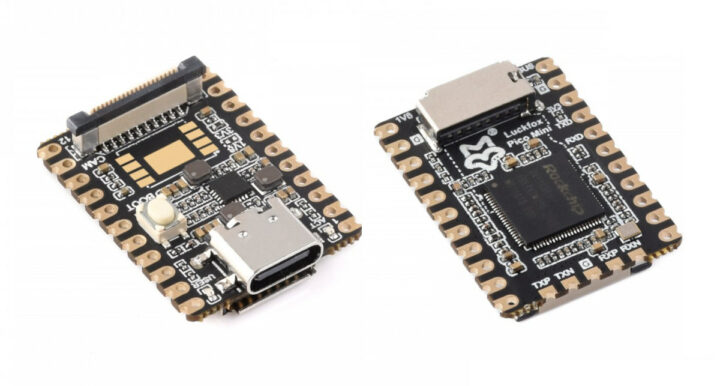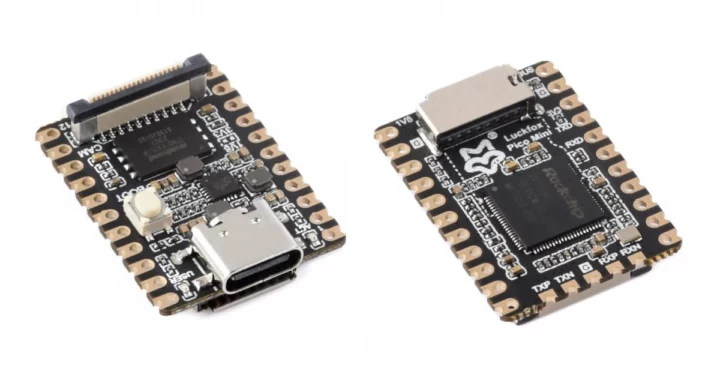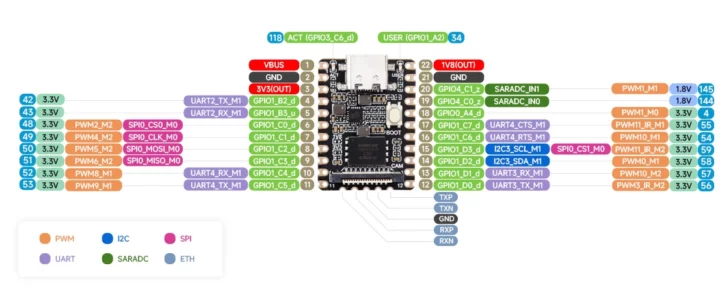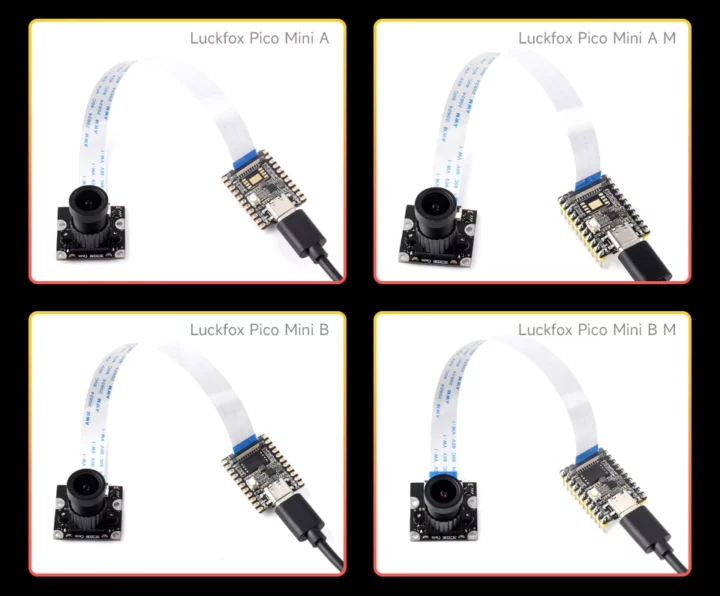Luckfox Pico Mini is a tiny (28 x 21 mm) board based on the Rockchip RV1103 Cortex-A7 camera SoC with a built-in 0.5 TOPS NPU, 64MB on-chip DDR2 RAM, USB-C port for power and data, two rows of headers with up to seventeen GPIOs, and five castellated holes for Ethernet.
Two versions are offered: the Pico Mini A with a microSD card slot or the Pico Mini B with an extra 128MB SPI NAND flash. Both boards are a shorter version of the Luckfox Pico with similar features but additional GPIOs and the Luckfox Pico Plus model also adds an RJ45 Ethernet port.

Luckfox Pico Mini A and B specifications:
- SoC – Rockchip RV1103 SoC
- CPU – Arm Cortex-A7 processor @ 1.2GHz + RISC-V core
- Memory – 64MB DDR2
- NPU – 0.5 TOPS NPU with support for INT4, INT8, and INT16
- ISP – 4M @ 30 fps ISP
- Storage
- MicroSD card slot
- Luckfox Pico Mini B only – 1Gbit (128MB) SPI NAND flash (W25N01GV)
- Camera – 2-lane MIPI CSI connector
- USB – USB 2.0 Host/Device Type-C port
- Expansion
- 2x 11-pin headers and castellated holes with up to 17x GPIOs, 14x PWM, 4x UART, 1x SPI, 1x I2C, 2x ADC, 5V (VBUS), 3.3V out, 1.8V out, and GND
- 5x castellated holes for Ethernet
- Misc
- BOOT button
- Act and user LEDs
- Power Supply – 5V via USB-C port
- Dimensions – 28.14 x 21.00 mm


All Rockchip RV1103/RV1106 Pico boards from Luckfox run the same lightweight version of Linux with Busybox that boots from a microSD card or the SPI flash. LuckFox provides instructions to get started, links to the images, PDF schematics, and additional information on the wiki. An SDK is provided that works with Ubuntu 22.04, but other versions of Ubuntu are supported through Docker.
You’ll need a USB Type-A to Type-C cable and A USB to UART debug board to get started, and most people will likely want to get the 3MP camera module based on the SmartSens SC3336 CMOS camera sensor.

Luckfox Pico Mini A and B boards are sold on AliExpress for $10.25 to $14.39 depending on the model and whether soldered GPIO headers are needed. You’ll also find all variants on Amazon with a small markup. The SC3336 3MP camera module can be purchased separately on Aliexpress for under $10 or Amazon for about $16. If 64MB DDR2 is not quite enough for your project, you’ll need one of the RV1106 boards with 128MB RAM such as the Luckfox Pico Ultra or LuckFox Pico Pro/Pico Max.

Jean-Luc started CNX Software in 2010 as a part-time endeavor, before quitting his job as a software engineering manager, and starting to write daily news, and reviews full time later in 2011.
Support CNX Software! Donate via cryptocurrencies, become a Patron on Patreon, or purchase goods on Amazon or Aliexpress





That’s gotta be a good contender for the smallest Linux board . . .
Patches that add support for this for Linux 6.11, if someone is interested:
https://codeberg.org/megi/linux/commits/branch/luckfox-6.11
Great. We have a patch series linedup for RV1109. Will be out soon. Is the NPU in this series RV1126/09/06/03 is same as the one in RK3588? Any ideas?
RV1106/3 seem to be newer, more related to RK356X.
RV1109 seems older.
Ok, do we have TRM or user manual for this SoC?
No.
I had found the RV1103 and 1106 datasheets a few weeks ago. They’re here, linked at the bottom of the first message: https://whycan.com/p_81040.html
This was asked before and some people mentioned the datasheets don’t have enough information to be useful.
https://www.cnx-software.com/2023/08/30/luckfox-pico-rockchip-rv1103-cortex-a7-risc-v-camera-board-comes-with-an-optional-ethernet-port/#comment-610210
What people are missing are TRMs. “Datasheets” can be found in many places, incl. on luckfox website.
It can hailjack PS4 11.00,really cool!
interesting, how? and any idea if there are updates on jailbreak of later firmawares, I accidentally updated to 11.52
I think those RV1103/RV1106 chips look really good but the A7 is really an old design.
I really wish that rockchip, amlogic and others really went ahead and adopted designs like A510.
I will forever dream of having 2x A510 for a tiny linux board.
Certainly too high of a dream, but there are SoCs like SG2002 that include an A53 and a high speed RISC-V(C906) chip(that you can select which one to use) so it shouldn’t be outright impossible.
I’m interested in performance driving a 1080 camera, because this could be and interesting tool to make network cameras, I tried espcam but they aren’t very powerful
Is 64MB-DDR enough for limited tasks and what’s RAM usage after boot?